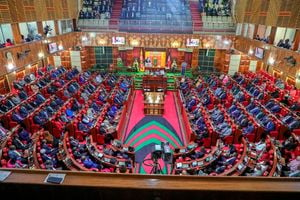Searching for eagle owls

Pictures of the lake on the high moor land on Aberdares and the lunch picnic in the Hagenia forest in Aberdares. Photo/RUPI MANGAT
What you need to know:
- Rupi Mangat visits the Aberdares and has a beautiful stay at Sandai
It’s a cool afternoon in the month of June. The peaks and vales of the Aberdares are shrouded in clouds so dense that the higher massif is invisible.
But the steep cliffs on the foothills are clear – solid rock with hollow crevices that only a trained eye can see.
“Point your binoculars to the hole above the green branch,” advises Paul Muriithi Kibuthu. I do so and see a bird on the stone’s face. It is invisible to the naked eye and even with the binoculars it takes a few moments to realise that the brown against the black is a bird with orange eyes.
“That’s the Makinder’s eagle owl,” states the owl man who until 16 years ago was a curio seller around Nyeri.
Muriithi’s life changed the day some Spanish tourists asked him if he had seen a particular bird. He had, and he guided the tourists to it. Today, Muriithi is championing the cause of a threatened bird that is endemic to the central highlands.
Leaving the car by the side of the road between Mweiga and Nyahururu, we clamber down the slopes through a maize farm. Muriithi continues with the story of the orange-eyes eagle owl, which we had spotted in a nearby site in 2009.
“This road site is one of the oldest of the 14 recorded and the most visited,” says the soft-spoken owl-man who has been collecting data for a decade, supported by The Peregrine Fund.
“We have had 11 successful breedings in a decade. The owl stays still as a statue and as the sky darkens it will fly out to hunt. It feeds on small birds, rodents and rabbits.”
Natural beauty
Considered an ill omen in most communities across the globe, the owl is one of the best rodent controllers and a better alternative to using pesticides. We leave as the sun begins to slink behind the Aberdares.
It’s dark driving through the farms to Sandai – meaning ‘beautiful’ in the local lingo – where Petra Allmendinger, who arrived in Kenya almost 25 years ago, chose to build her house.
Perched between Mt Kenya and the Aberdares, the elegant home-stay is a dream. A log fire burns in the living room, which on clear days boasts views of both massifs. A delicious hot dinner awaits.
I’m excited to be back because there have been regular sightings of the African wild dog – one of the most endangered canines until recently. We search the terrain for the wild dogs that at one time were shot on sight because they were considered pests.
Wild grasses pattern the lawns where the horses graze and grass owls nest. Sammy Mugo is the authority on them, having raised three chicks to maturity at Sandai in 2009.
After a hearty breakfast, we head for the moorlands high on the Aberdares through the bamboo zone and the awesome Hagenia forest that has trees almost two centuries old.
“We are at the centre of the country,” says Felix Mwangangi, the senior warden of Aberdares National Park.
As we stop for a picnic in a hidden grove of hagenia forest, the fresh air is intoxicating, like sparkling champagne. The endemic Jackson’s Francolin scuttle.
“This is a water tower,” Mwangangi continues. “Nairobi gets 99.9 per cent of its water from the Aberdares. The Tana (Kenya’s longest river) gets 50 per cent of its water from the Aberdares.”
Camera traps
High on the moors, the Hagenia forest thins out and is replaced by the oil-rich heather and grasses, where crystal clear streams flow and tarns mirror the peaks. The highest peak - Ol Donyo La Satima - shows.
“We have camera traps fitted in the Hagenia forest to monitor the bongo,” Mwangangi tells us.
Once abundant in the high forests of the Cheranganis, Mount Kenya, Eburru and Aberdares, few are found in the wild although Mwangangi is excited that with improved security, the free-ranging bongo is frequently sighted.
In 2004 American Zoological Institutions joined hands with the Bongo Species Survival Plan in returning 18 of their zoo-bred bongo to Kenya.
They are at the Mount Kenya Wildlife Conservancy. I’m hoping to see one of the 154 bongo with their ivory-tipped horns but instead meet with herds of buffaloes, elephants and warthogs heading to the waterholes.




